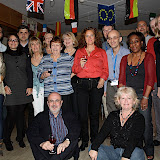
“Dumb” candy? I get this harsh warning even after she ate some of the tastiest hummus she’s ever had? Hummus I made myself? …sigh…I get no respect. (OK, so I do, but I had to find a way to work hummus and Halloween into the same blog.)
“What exactly is dumb candy?” I asked.
Carlene rattled off a litany of things including Good ‘n Plenty, Almond Joy, Mounds, Mary Janes, 3 Musketeers (blasphemous!), Necco Wafers, and Smarties, which she retracted because, on second thought, she likes Smarties. Who doesn’t like a mouthful of artificially flavored sugar? Heck, I do! Seriously. I love Smarties. Heart them. I don’t eat them anymore, though. (But I secretly want to.)
I told her it was important that I buy Halloween candy that is not enticing to me (following
Lori’s advice from last year) because it has to sit on top of my refrigerator for a few days (see last year’s blog, “
The Scariest Day of the Year”) and, as Carlene knows, chocolate and me go WAY back.
So I bought three big combo bags filled with boxes of Skittles and Starburst – candy I just don’t understand. Or eat (which is the whole purpose, right?). All of it is perched on the top of my refrigerator, looking down at me like an owl, but I’m oblivious because I could care less. If they were Snickers, though, we wouldn’t be having this conversation. I’d be head first in the bag.
Trick or treating is tomorrow here in Podunkville. Someone keeps forgetting to send our borough the memo that Halloween is the 31st. I can’t remember the last time kids in m town trick or treated on the actual Halloween day. Thank goodness my grandkids in Pittsburgh will trick or treat on Saturday night and I’ll be there to see them in their costumes! Whoohoo! And WHY will I be in Pittsburgh on Saturday night, you ask? (You did want to know, right?)
Well….
TEASER ALERT: I’m leaving Sunday morning, very early, for New York City where I’ll walk around Central Park, eat some ethnic food, stay in a hotel and work out on some awesome cardio equipment before wandering over to 30 Rock on Monday to be on the Today Show! I promise more info on that in a few days.
But for now, I want to talk about hummus!
I love hummus, but the kind that really floats my boat is from Trader Joe’s, and I don’t get there enough to keep it in stock. Tribe is OK in a pinch, but I really like TJ’s horseradish or roasted red pepper hummus. After a hummus dry spell, I decided to scour my cookbooks and the Internet for recipes. I conquered refried beans, after all. I figured I could do hummus.

I bought some tahini (slimy, gunky stuff that it is) and made my first batch of hummus a few weeks ago. Just some garbanzo beans, tahini, lemon juice, horseradish…typical plain hummus. It was alright, but I knew I could do better. And I did. Last Saturday, I combined two hummus recipes – taking the best options from both – and made a nice spicy hummus that I’ll definitely make again. Here’s the recipe:
Sun-Dried Tomato Hummus
4-5 sun-dried tomato halves (dried, not packed in oil)
1 can chickpeas (15 oz or so)
4 cloves garlic
2 T tahini
3 T lemon juice
1/3 C fat-free Greek yogurt
¼ t each salt and pepper
1 t curry powder
½ t ground cumin
½ t ground coriander
Finely chop the tomato halves and set aside. Put everything else in a food processor and process until smooth. Add the tomatoes and put in the refrigerator for a few hours.
This makes about 1¾ C of hummus. I love it on toasted Arnolds Sandwich Thins or with homemade pita chips.
I’m looking forward to finding and perfecting more hummus recipes. Store bought be damned! Just like I will never buy canned soup ever again, hummus will not be on my grocery list unless it’s an emergency. Wait…whoever has a hummus emergency? I guess if anyone does it will be me.
Anyway, I’ve got a big ass jar of tahini and I intend to use it well. I’ve also got the rest of those sun-dried tomatoes sitting in my fridge. What to do, what to do….If you have any ideas, pass them on!
Happy Halloween, everyone! What did you buy to pass out to the trick or treaters?

 If you happen to be one of the 50 million people who use an iPhone or iTouch check out these two free apps on losing the belly. They are each a collection of the 15 best videos you will find on YouTube to help you lose weight. Included is diet and exercise advice.
If you happen to be one of the 50 million people who use an iPhone or iTouch check out these two free apps on losing the belly. They are each a collection of the 15 best videos you will find on YouTube to help you lose weight. Included is diet and exercise advice.


















.png)
.png)

 Roseann lost and gained many dozens of pounds when she was in her twenties. When she turned 30 however, she decided to make a major lifestyle change. She went on to lose 90 pounds.
Roseann lost and gained many dozens of pounds when she was in her twenties. When she turned 30 however, she decided to make a major lifestyle change. She went on to lose 90 pounds. 